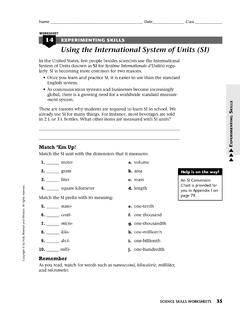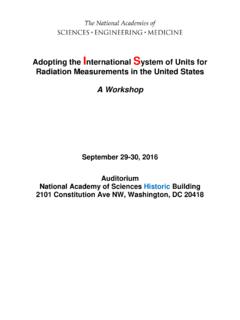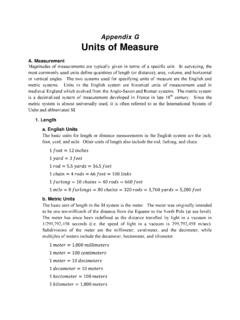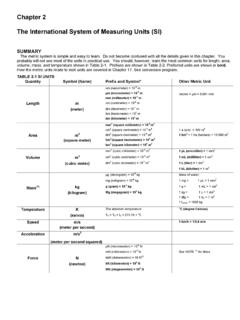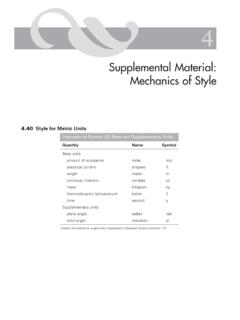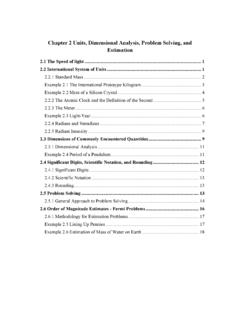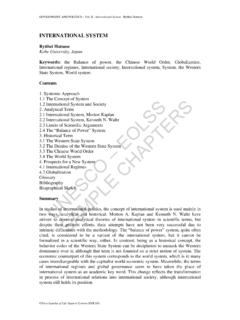Transcription of International System of Units, SI - scool.larc.nasa.gov
1 I. Vertical Distances Learning Objectives Students will: Understand that vertical distances are measured with the same units as horizontal distances Compare distances both horizontal and vertical Order distances in appropriate sequence Estimated Time: 20-30 minutes Materials: Paper/Pencils Formula Sheet with Distance Conversion (Optional, only if including step 2) Vocabulary: Altitude- the vertical distance or height measured from sea level. unit of measurement - Any division of quantity that has been accepted as a standard of measurement or exchange (for example a System of units such as the International System of Units, SI) (MND, Understanding Scientific Units) Background Summary: Distance (or length) is a measure of how far apart two objects are, how long an object is, or how tall an object is. Vertical distances are just like horizontal distances. It may be harder for people to think of vertical distances, because we typically only travel horizontally. In this activity students should begin by comparing distances (either lengths or heights) of objects that are familiar to them.
2 Distances can be measured or described by using different units of measurement. Some units of measurement that students are probably familiar with are: feet, inches, and miles. The units meter or kilometer are other units of measurement. The metric System uses the meter as a base unit for distance. This System uses a base unit and adds prefixes for longer or shorter units of measurement. It uses powers of 10 to convert from one unit to another. 1 meter is about 3 feet. 1000 meters is 1 kilometer (km). As students become more comfortable with the concept of vertical distances, the teacher should begin to introduce distances that are much farther away, beyond the distance the eye can see. The Earth s atmosphere extends to almost 800 kilometers (about 500 miles). At this level the Earth s atmosphere begins to blend with space. In the next activity the students will explore the profile of the Earth s atmosphere, so in this activity the teacher should begin having students think about far distances.
3 Steps: 1. Ask the students to describe horizontal distances they are familiar with ( , how long is a football field, how long is an Olympic size pool, how far is one city from another). Ask students how they know these lengths. How do they know if one of the items mentioned is longer or shorter than another item? 2. Ask the students to guess how tall certain objects are. Teachers should select objects that are familiar to students or within their area ( , a local building, a particular tree at the school, or a flag pole at the school). Ask the students which of these objects is tallest and which is shortest. *For Steps 3-5 See Vertical Distances Student Worksheet 3.* Now that students have discussed both horizontal and vertical distances ask the students which is a greater distance: the length of a football field, the height of the Statue of Liberty, or the length of an Olympic Pool? Ask students to explain their answers. 4.* Tell students the length of each of these items: football field is 91 meters long Statue of Liberty is about 46 meters high Olympic Pool is 50 meters long Now that students have a common unit (meters) by which to compare the length or heights of these items, ask students to order these three objects from greatest to shortest length.
4 Ask students which two of the three items are more similar in length? Discuss with the class that the Statue of Liberty is the shortest of the three objects. It is also just a little shorter than the length of an Olympic Pool (50 meters). The Statue of Liberty and an Olympic Pool are more similar in distance than the Statue of Liberty and a football field. It would take about two Statues of Liberty atop each other to match the length of a football field. 5.* Discuss items that are much taller or farther away. Ask students if they have ever seen airplanes flying in the sky. Were they flying in the clouds? Let students know that most airplanes fly above 30,000 feet. That s about 9,000 meters high. Ask students how many football fields it would take to get to this height. (It would require about 100 football fields stacked end-zone to end-zone to reach the altitude at which airplanes fly. This is about as high up as the top of Mount Everest.) 6.* Discuss units of measurement and introduce the metric System .
5 Discuss how a meter is another unit to measure distance. This unit is a part of the metric System . Have students review the metric distance chart on their worksheet. Ask students how many centimeters are in a meter? If teachers have a meter stick, teachers can show this to students and have them see the centimeter marks. Now ask students if airplanes fly above 9,000 meters, how many kilometers is this (9 km)? Below is a list of distances for reference: 1. Height of a Basketball Hoop: 10 feet, or 3 meters, or .003 km 2. Height of the Statue of Liberty: 151 feet, or 46 meters, or .046 km 3. Length of Olympic Swimming Pool: 50 meters or .05 km 3. Length of a Football Field: 100 yards, 300 feet, or 91 meters, or .091 km 4. Burj Khalifa (tallest building in the world, Dubai): 828 meters tall or km 5. Distance between Panama City, FL and Jacksonville, FL: 280 miles, or 451 km 6. Height of Mount Everest: 29,029 feet, or 8,848 meters, or km 7. Altitude Jet Airplanes Fly: above 30,000 feet, or about 9,000 meters, or 9 km 8.
6 Maximum Height of Weather Balloons: 137,000 feet, or 41,500 meters, or km 9. Altitude the Space Shuttle Orbits Earth: 984,252 feet, or 300,000 meters, or 300 km 10. Altitude of Polar Orbiting Satellite: 2,296,588 feet, or 700,000 meters, or 700 km 7. Checking for Understanding: Have students order distances (both vertical and horizontal) from shortest to longest. Teachers can write a short list of objects/distances on the board and have students write down their answer on their own paper. Discuss with students how they made their selection (by estimating the distances). Students did not know the exact distances or heights of these objects, so how did they make their guess? Vertical Distances Student Worksheet 1. Distance is a measure of how far apart two objects are, how long an object is, or how tall an object is. Which object do you think is a greater distance? (Circle your answer) Length of a football field Height of the Statue of Liberty Length of an Olympic Pool Explain your choice.
7 2. Distances can be measured using different units of measurement. Some units of measurement you are probably familiar with are: feet, inches, and miles. The unit , meter, is another unit of measurement. 1 meter is about 3 feet. If you know the distance of objects you can compare the distances. Now that your teacher has told you the measurement of distance for a football field, the Statue of Liberty, and an Olympic pool, list the three objects in order of distance: _____ (greatest distance) _____ (next shortest distance) _____ (shortest distance) Which two objects are more similar in distance? (Circle the 2 objects that are more similar in distance) Length of a football field Height of the Statue of Liberty Length of an Olympic Pool 3. Some distances can be very far away. For example, from the ground, airplanes that are flying high in the sky look small. Airplanes usually fly above 30,000 feet. That s about 9,000 meters. Now that you know the length of a football field in meters and the height at which air planes How many football fields would need to be stacked from end-zone to end-zone to reach the height that airplanes fly?
8 _____ 4. A meter is another unit to measure distance. This is a part of the metric System . The metric System uses a base unit and adds prefixes for longer or shorter units of measurement. Kilometer (km) 1 km = 1,000 m A kilometer is about the length of 100 school buses lined up end to end. Meter (m) 1 m = 100 cm A meter is about half the height of a door. Decimeter (dm) 1 dm = 10 cm A decimeter is about the width of your teacher's hand. Centimeter (cm) 1 cm = 10 mm A centimeter is about the width of a pencil. Since 1000 meters are 1 kilometer, what is the height at which airplanes fly in kilometers? _____ km

